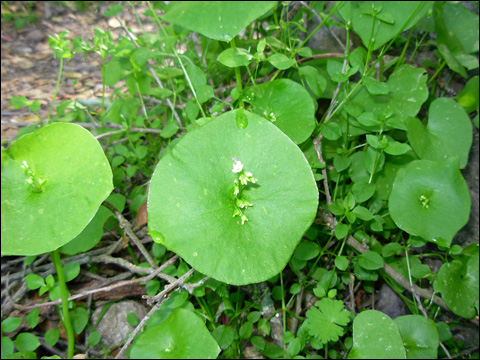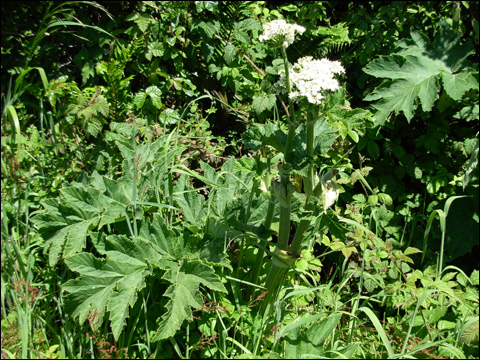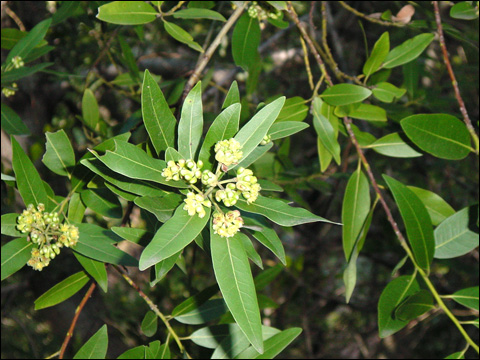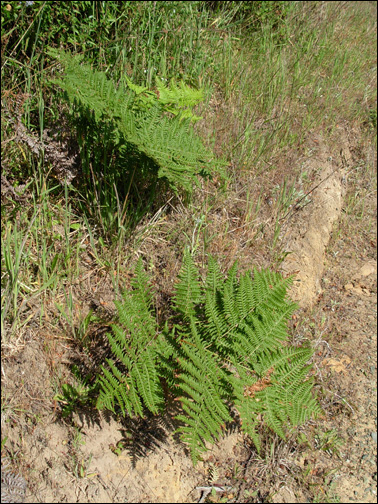
VEGETATION
Spanish clover (Lotus purshianus): The flower of his clover blooms yellow to pink, and varies in form from one area to the next (Hickman 1993:620). Clover was gathered and eaten as a spring food (Heizer & Elsasser 1980:100). Foliage was eaten by the Ohlone (Bocek 1984:250).
Clover (Trifolium scaldi): Eaten as a green, it can cause bloating. Bay nuts were eaten with it, to prevent bloating. It was also eaten with salt (11/06/05 CNPS lecture by Charles Kennard).
Miner’s lettuce (Claytonia perfoliata): It’s use is documented by Powers, but not for a specific culture (Powers 1976:424-425). This plant is seasonally common in Ohlone territory. It tastes much like lettuce eaten raw, and can also be boiled as a potherb (author). The Ohlone ate the leaves raw in early spring, and boiled or steamed them later in the season (Bocek 1984:251).

Miner's lettuce
Lambs quarters (Chenopodium album): It was used for greens (11/06/05 CNPS lecture by Charles Kennard).
Soap plant or Amole (Chlorogalum pomeridianum): Leaves were allowed to wilt, then were removed from young soap plants. These were roasted in an earth oven and eaten by the Pomo (Stevens and Ryan 1997:35). Immature soap plant leaves are also documented as being eaten by the Ohlone (Bocek 1984:255). (See Geophytes for photo)
Bracken fern (Pteridium aquilinum var. pubescens): Harrington’s notes suggest the fiddleheads were eaten raw or cooked (Bocek 1984:247).
Curly dock (Rumex crispus): The leaves were eaten as greens by the Ohlone and the seeds were also eaten as pinole (Bocek 1984:249). This plant is identified as a native of Eurasia (Hickman 1993:894), so its use must have been acquired after 1769 and the arrival of the Spanish (author).
Cottonwood (Populus spp.): Harrington’s notes indicate the inner bark could be eaten (Bocek 1984:248).
White alder (Alnus rombifolia): The inner bark could be eaten (Bocek 1984:248), speaking of the Ohlone.
Sun cup (Camissonia ovata, synonym: Oenothera ovata): Ohlone ate the leaves raw, steamed or boiled (Bocek 1984:250).
Stonecrop (Sedum spp.) The Ohlone ate the leaves and stems of this succulent raw (Bocek 1984:251).
Common cow parsnip (Heracleum spondylium ssp. montanum): Harrington’s notes states the roots and leaves were eaten, usually after boiling (Bocek 1984:251).

Common cow parsnip
Water parsley (Oenanthe sarmentosa): Harrington’s notes state the stems were eaten raw or they were cooked (Bocek 1984:251). Readers, please be aware this plant is easily confused with deadly water hemlock (author).
Mushrooms: There are several words for mushroom and they are recorded as having been roasted in coals, sprinkled in salt and eaten. The species utilized were not recorded (Bocek 1084:247).
Sweet alyssum (Lobularia maritime): Stems were eaten raw (Bocek 1984:252). This plant is not native to California, so its use must have post-dated the arrival of the Spanish (author).
FIBER PLANTS
I have not found documentation on the specific fiber plants utilized by the Ohlone Peoples. Here are those utilized by neighboring Native groups.
Dogbane, Indian hemp (Apocynum cannabinum): Despite its common name “Indian hemp” and the Latin species name resembling cannibus, this plant’s only similarity to marijuana is its excellent fiber. It was the favored fiber plant throughout most of California (Heizer & Elsasser 1980:138). Fiber is gathered after winter dormancy is well established, certainly after first frost. In my experience January or February is an ideal time to gather in the Bay Area (author). The dry and dormant stem is crushed longitudinally and split open to allow the fiber to be removed. It is cleaned and twisted into cordage (Stevens and Ryan 1997:47).
Iris: Species within Ohlone territory include: I. douglasiana, I. fernaldii, I. longipetala, I microsiphon. (Jepson 1996:1153).
Ground Iris (Iris microsiphon) was the preferred fiber for fishing nets along California’s Northern coast (Heizer & Elsasser 1980:138). Iris leaves (Iris fernaldii) were harvested at the end of summer. Iris beds were also burned to prune back old growth (USDA National Resource Conservation website 2010). I have not found its use documented specifically for the Ohlone, though it is counterintuitive to think this resource would be overlooked (author). The plant grows within Ohlone territory, primarily within the coastal fog belt. Harringrton’s Ohlone informants lived in an area where this plant is less common.
For more northern groups it was gathered after brown, dampened, then the side vein was removed. Only the vein was used for fiber. Deer snares and nets of this material were also made by the Klamath. The maker of a snare (Klamath) rented it out in exchange for meat (11/06/05 CNPS lecture by Charles Kennard).
Leather root (Hyata macrostatia): This plant is in the pea family. The stem has the best fiber if cut in the fall. It is very strong. The root also can be used for its fiber. The plant was also used in a tea (11/06/05 CNPS lecture by Charles Kennard).
Milkweed (Asclepias spp.): This plant occurs in the Bay Area. To the south, north and east, it was an important fiber plant. In my experience, it is best gathered early in dormancy, October/November, prior to heavy rains (author). The fiber is processed much as dogbane is (Stevens and Ryan 997:47).

Milkweed flowers
Ninebark or California hemp (Pysocarpus capitatus): It was used as a fiber plant (11/06/05 CNPS lecture by Charles Kennard).
Rush (Juncus spp.): Harrington’s notes identify the leaves and stems as a cordage material use by the Ohlone (Bocek 1984:255).
Yellow beach luipine (apparently Lupinus albifrons): The roots were used for fiber/cordage (11/06/05 CNPS lecture by Charles Kennard).
WOOD FOR BOWS AND ARROW SHAFT MATERIALS
Arrow manufacture requires choosing as straight a shaft as possible and then straightening it. Light arrow shaft with a heavier point improves performance, so hollow, lightweight shafts were often preferred. Such hollow or pithy shafts required sinew wrap reinforcement and a hardwood foreshaft. A stone point could be added to the foreshaft or the hardwood could be sharpened. Foreshafted arrows with no stone point were commonly used for small game. Some groups made foreshafts detachable, so tips were interchangeable (author).
Blue elderberry (Sambucus caerulea) (syn. S. cerulea, S. mexicana, S. nigra ssp. caerulea) California Indians had many uses for this plant. Berries from the Blue elderberry were eaten. The wood from straight shoots was used for arrow shaft material and for friction-fire spindles. Larger diameter shoots could be fashioned into California flutes. Even larger branches could be made into clapper sticks. The Chumash self bow was also sometimes made of elderberry wood (Timbrook 2007:195). Harrington’s Ohlone informants identify it as a arrow shaft material (Bocek 1984:254). Father Crespi’s notes, from the 1772 expedition, as they approach Martinez area compares Ohlone bows to those seen on the Channel Islands, in Chumash territory. He states they were identical (Bean 1994:19). Chumash self bow was sometimes made of elderberry (Timbrook 2007:195). (See Berries for photo)
California buckeye (Aesculus californica): Powers documents its use by California Indians, but does not specify which cultures (Powers 1976:422). (See Nuts for photo)
Chamise (Adenostoma fasciculatum): This is a chaparral plant with dense wood. Harrington’s notes confirm its use by the Ohlone in arrow foreshaft construction (Bocek 1984:249).
California laurel, also known locally as Bay laurel and in Oregon as Oregon myrtle (Umbellularia californica): Contemporary use of California laurel in bow construction suggests it would have been an appropriate bow wood choice. To date the author has found no documentation of its use as a bow wood by the Ohlone.

California laurel
Common reed (Phragmitis communis): Though not common today, this reed does occur within the San Francisco Bay Area. I have not yet seen reliable documentation of its use within Ohlone territory, but it is used by other California native groups to make the main shaft of an arrow (author). This reed was preferred in Southern California (Heizer and Elsasser 1980:117). This reed can be straightened by heat and bending. It is hollow. Phragmitis was used in combination with a hardwood foreshaft.
Hazelnut (Corylus cornuta var californica): Harrington’s notes identify it as a wood used by the Ohlone for arrow shafts (Bocek 1984:248).
Holly leaf cherry, Islay (Prunus ilicifolia): It was occasionally used for bow wood by the Ohlone (Bocek 1984:249). (See Nuts for photo, also Basketry)
Mountain mahogany (Cerocarpus spp.): This chaparral shrub has extremely dense wood. In many areas, it was used to fashion hardwood tools and is appropriate for arrow foreshafts. I have not seen its use recorded for the Ohlone (author).
Ocean spray (Holodiscus discolor): The straight shoots can be used for arrow shafts. I have not yet seen reliable documentation of its use within Ohlone territory, though it can produce straight shafts of appropriate diameter (author).
Toyon (Hetermles arbutifolia): A hardwood appropriate for arrow foreshafts and a variety of wood tools. I have not yet seen reliable documentation of its use within Ohlone territory (author).
Western yew (Taxus brevifolia): It was the favored bow wood north of Santa Cruz. Characteristics of this wood made it a favored bow wood in Europe as well (Heizer & Elsasser 1980:140). Father Crespi, during the 1772 expedition through Ohlone territory, claims the bows of the Ohlone closely resemble those of the Chumash of the Santa Barbara Channel who also used yew (Bean 1994:18). Harrinton’s notes confirm its use among the Ohlone (Bocek 1984:248).
White alder (Alnus rhombifolia): Small straight branches were used by the Pomo to make arrows (Stevens and Ryan 1997:24). (See also Dye Plants)
Willow (Salix spp.): Powers documents its use as a shaft material by California Indians, but does not specify which culture (Powers 1976:422). (See also Basketry)
BASKETRY MATERIALS
Of the basket materials listed below, basketry sedge, bulrush/tule (scirpus), bracken fern, horsetail, willow and possibly hazel are documented as used by the Ohlone Peoples (Shanks 2006:22, 30, 32). Some basketry plants living within the Ohlone biosphere, but not documented as used by the Ohlone, have been included for your interest.
Arroyo and Sandbar willow (Salix spp.): Harrington’s notes list shoots of Salix lasiolepis (arroyo willow) and Salix hinsiana (sandbar willow) were used by the Ohlone in constructing baskets (Bocek 1984:248-249). It is listed as a preferred warp material in Ohlone basketry (Mathewson 1998:148, 167, 179). Willow branchlets are used by many native people in basket construction. Winter willow is gathered after dormancy, and is more resilient than willow gathered in the spring. It may be used without removing the bark, or may be boiled or steamed to remove the bark. Spring willow is gathered as soon as the sap is running (February in the Bay Area) and the bark is peeled immediately. Peeled willow is used for coiled work, and the warp of some twined baskets (Shanks 2006:39) (author: from basket-class notes/ Beverly Ortiz).

Sandbar willow fish trap
Basket rush (Juncus textiles): The plant was ued for all mission baskets and for thatching homes (nonspecific cultural group) (11/06/05 CNPS lecture by Charles Kennard). I have not seen specific reference to this species as used by the Ohlone as a basket material (author).
Basketry sedge (Carex mendocinoensis) and (Carex barberi): The rhizome is carefully dug, washed, split and cleaned. It is then dried well prior to use in basketry. This practice of drying insures the finished basket does not shrink and loosen the weave. Ohlone coiled baskets utilized this material (author: Class notes/ Beverly Ortiz), (Shanks 2006:22), (Bocek 1984:255).
Big leaf maple (Acer macrophyllum): Long shoots from coppiced plants are split for the white element in some baskets (Unspecified Native group) (11/06/05 CNPS lecture by Charles Kennard). The tree is common within Ohlone territory (author).
Bulrush (Scirpus spp.): The short root (1 foot) is dyed black with walnut or in mud darkened with rusty nails. It is used in basketry by Central California Indians (Shanks 2006:21), (11/06/05 CNPS lecture by Charles Kennard). Harrington’s notes confirm the use of its roots in Ohlone basketry (Bocek 1984:255). The rootlets were dyed black and used in basketry (Ortiz, class notes). The above ground portions of this plant are also excellent basketry material and used by other California Indians (Shanks 2006:62, 63).
Bracken fern (Pteridium aquilinum): The long rhizome is dug up and is opened to reveal 2 membranes used in basketry. Harrington confirms its use by the Ohlone (Bocek 1984:247). (see also Other Uses of Plants and Vegetation)

Bracken fern
Chamise (Adostoma fasciularis): It is listed as one of the materials used in Ohlone basketry (Boecek 1984:252,249). This is a common chaparral plant with many uses (see Wood for Bows and Arrow Shaft Materials).
Common horsetail (Equisetum arvense) and Common scouring rush (Equisetum hyemale): The split rhizomes were sometimes used as a black element in Ohlone basket design (Bocek 1984:247). This rhizome is failrly fragile when gathered, but becomes much stronger after drying and rehydrating. It is naturally black in the specimen I gathered (author).
Hazel (Corylus cornutta): It is listed as a preferred warp material in Ohlone basketry (Mathewson 1998:148, 167, 179). Harrington’s notes list it as an Ohlone basket rim material (Bocek 1984:248-429). The plant can be coppiced or trimmed to produce longer unbranched growth. Small diameter sticks are gathered as they begin to leaf out when they can be easily peeled. The resulting stick is both flexible and very strong (author’s experience). (See also Basketry, Arrows, Nuts)
Poison oak (Toxicodendron diversiloba): Ohlone used the shoots for basketry (Bocek 1984:251). This plant contains urushiol oil which causes contact dermatitis for anyone sensitive to the oil. The degree to which Ohlone were affected is unknown, but there are many plants listed as a treatment for poison oak dermatitis, implying many individuals were sensitive to this plant. Harrington’s interviews with Ohlone didn’t elaborate about how the plant was gathered or processed (author).
Redwood (Sequoia sempervirens): Harrington’s notes list the sprouts from burls as a basketry material (Bocek 1984:248).
Rush (Juncus), (Juncus affaris): Leaves used for basketry practice (11/06/05 CNPS lecture by Charles Kennard). A single example of use in Ohlone baskets of this or a similar rush exists (Shanks 2006:33) and the family, Juncus, is listed by Harrington as an Ohlone basket material (leaf), as a textile material (leaf and stem) and as stuffing (leaf and stem) (Bocek 1984:255). The term textile implies it was woven into something, perhaps a basket or a mat (author).
Tule (Shoenoplectus spp.): Harrington’s notes list the tule as a basketry plant (Bocek 1984:255). This common wetland plant had many uses. (See Other Uses and Geophytes)
![]()
We hope the information on the PrimitiveWays website is both instructional and enjoyable. Understand that no warranty or guarantee is included. We expect adults to act responsibly and children to be supervised by a responsible adult. If you use the information on this site to create your own projects or if you try techniques described on PrimitiveWays, behave in accordance with applicable laws, and think about the sustainability of natural resources. Using tools or techniques described on PrimitiveWays can be dangerous with exposure to heavy, sharp or pointed objects, fire, stone tools and hazards present in outdoor settings. Without proper care and caution, or if done incorrectly, there is a risk of property damage, personal injury or even death. So, be advised: Anyone using any information provided on the PrimitiveWays website assumes responsibility for using proper care and caution to protect property, the life, health and safety of himself or herself and all others. He or she expressly assumes all risk of harm or damage to all persons or property proximately caused by the use of this information.
© PrimitiveWays 2016